Magnificent magnolias
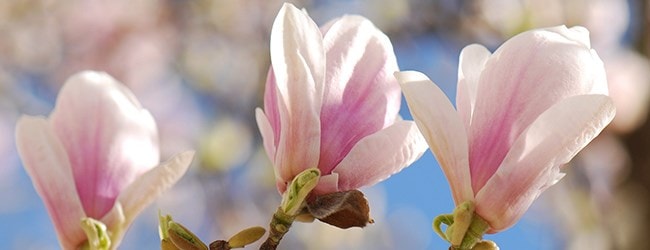 |
Certain plants seem to capture the spirit of the moment and
Magnolias take centre stage just when the garden is full of promise. But these plants have been on the planet since the age of the dinosaur when the earth existed as one large land mass. When continental drift occurred some found themselves in eastern America: others were firmly rooted in eastern Asia.
This ancient provenance means that
magnolias have extravagant flowers unlike any other, but you must choose one that matches your space and your conditions. Some form huge trees and take twenty years to flower. Others suit a small garden and some are shrubby in habit and can be grown in the garden, or in a container. Flower shape varies and those with huge goblets can be prone to frost damage for they trap cold air within each chalice. Starry-flowered forms, with gaps between the petals, shrug off early frosts because the cold air flows through the gaps. Whichever you choose however, try to find the most frost-free position for your magnolia so that the flowers stay pristine.
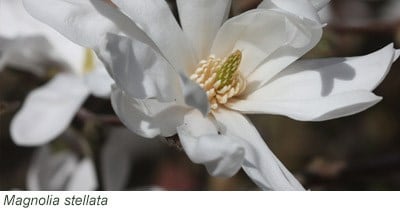
The easiest of all is
Magnolia stellata, the
star magnolia. That’s because it's tolerant of a wide range of soil types (it will grow in alkaline as well as its preferred acid soil), and it’s slow growing. In most gardens it will resemble a medium-sized deciduous shrub, although it needs moisture-retentive soil and a sunny position to flower well. The starry white flowers of this Japanese species have a delicate, oriental air but this has been grown in British gardens since the late 1870’s. Normally the flowers appear in April, smothering the twiggy branches.

Magnolia × loebneri 'Leonard Messel', raised at Nymans Garden in Sussex in the 1950s, is a fuller-petalled
magnolia with twelve rounded spatula-shaped petals. The flower colour of many
magnolias has a tendency to vary according to weather conditions. In a good spring, when temperatures are higher, the flowers develop rich-pink petals, while cooler winter conditions produce paler flowers. ‘
Leonard Messel’ has a languid air, with petals that swoon downwards. It's best in good light and often takes a while to become established.
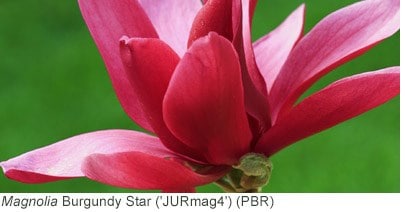
There is a range of hybrid magnolias from New Zealand that remain relatively small and flower early on in their lives.
Magnolia ‘Burgundy Star’ (JURmag4) (PBR) has lightly fragrant, hand-sized claret blooms that hover between star and chalice. ‘
Black Tulip’ (probably a hybrid between two early Jury hybrids called ‘Vulcan’ and ‘Iolanthe’) has lightly-fragrant claret-coloured blooms that are more waterlily in shape. Given good light, something New Zealand has plenty of, this can be covered in bloom between late April and May.
 Magnolia ‘Felix Jury’ (JurMag2) (PBR)
Magnolia ‘Felix Jury’ (JurMag2) (PBR), a
magnolia that forms a small tree, has bright-pink rounded flowers that stand out on bare branches. It’s an ideal
magnolia for a small garden whether added to the back of a border or grown in the lawn as a specimen. Like all
magnolias, it will resent root disturbance, so give it a dedicated position because it is impossible to dig under a
magnolia without distressing it.
The
Fairy series are compact evergreen
magnolias reaching on average 3m at most. These are very suitable for smaller gardens.
Magnolia ‘Fairy Blush’ (MicJur01) (PBR) has saucer-shaped apple blossom pink flowers that appear in spring and the petals are thickly textured.
Magnolia ‘Fairy Cream’ (MicJur02) (PBR) has cup-shaped buds that open to ivory flowers.
Magnolia ‘Fairy White’ (MicJur05) (PBR) has pure-white flowers and
‘Honey Tulip’ (JURmag5’) (PBR) is a toffee-yellow
magnolia with cup-shaped flowers. In severe winters
Fairy hybrids may shed foliage, but they will recover when spring arrives. Try to find a warm position, for these
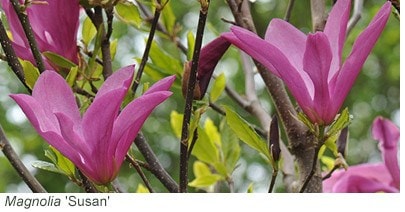
Plant breeders have been hybridising
magnolias for decades and one series, known as the ‘eight little girls’, was raised by breeders in Washington DC in the 1960s. ‘
Susan’, a cross between the pink star magnolia M. stellata ‘Rosea’ and M. liliiflora, has the darkest flowers of them all. It forms a wide tree reaching 4m, with goblet-shaped, sweetly fragrant flowers that are upright and slender. These arrive in April before the foliage, making
‘Susan’ the most widely grown of the ‘eight little girls’.
The upright stance and deep, purple-pink flowers of ‘
Susan’ are inherited from
M. liliiflora ‘Nigra’ which does well in British gardens. Given a sheltered position, this will flower profusely and reach 3m. The darker petals have a habit of swooning to reveal a tempting glimpse of the pale inners, so it’s very gentle on the eye and widely grown and admired.

M.liliiflora is also a parent of
M. x soulangeana, the most commonly grown
magnolia in Britain. This treelike
magnolia, hybridised in France, needs space because it will turn into a large tree in time. In April, warm white flowers appear with a hint of pink and the branches sprawl over the ground providing flower from the ground upwards. It’s long-lived and many were planted over a hundred years ago. It also tolerates a range of conditions, flowering abundantly in the second half of April year after year.
Magnolia × soulangeana 'Alba Superba' flowers early, so needs a position well away from frosts if possible. It isn’t a harsh white despite the name 'Alba'. The flowers have a pink-purple base to their cup and saucer arrangement, so it's soft and feminine. It will reach 7m and, like many
magnolias, it will escape frost damage if planted on a slope, or at the top of a slope - so that any cold air can roll away.
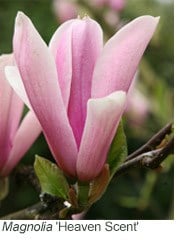
‘
Heaven Scent’ also has
M. liliiflora ‘Nigra’ parentage and the upright flowers are a strong-pink, bred in California during the mid-1950s, it’s one of the most reliable
magnolias of all, flowering year after year every April.
Although
magnolias tend to grow on acid soil in the wild, many manage to thrive on ordinary garden soil.
Magnolia wilsonii, eminently suitable for a small garden. This large shrub has pendent, pure-white flowers in late May, so they generally miss any frost. Inside each ivory-white flower is a boss of maroon-red stamens and there are long red seed receptacles which look spectacular by autumn. This adaptable
magnolia is also tolerant of light shade, doing best in a sheltered position.
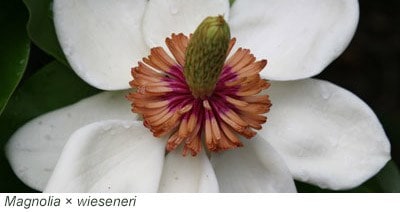
You could also consider the highly scented summer-flowering
Magnolia x wiesneri, which is described in various ways as vanilla, pineapple or spice. This large, multi-stemmed shrub, with the leathery foliage, will grow quickly once established - although it can be slow to get going. Upward-facing, cream-white saucer-shaped flowers are studded with a prominent boss of almost orange stamens.
No one could argue or start a debate about the fragrance of the American evergreen,
M. grandiflora, for it’s citrus and lemon without a doubt. The huge flowers appear in summer, one or two at a time, from enormous buds. The large, leathery green foliage usually has a brown felted underside for added interest. Most have to grow this as a wall shrub, rather than in the open, as it demands lots of space. Many a grand house has one of these giants on a warm south-facing wall. Whichever
magnolia you choose however, the ample flowers will light up your garden in a completely unique way.







 Magnolia ‘Felix Jury’ (JurMag2) (PBR)
Magnolia ‘Felix Jury’ (JurMag2) (PBR)



